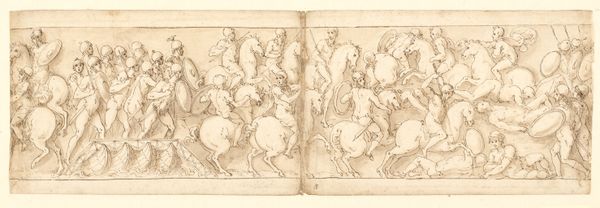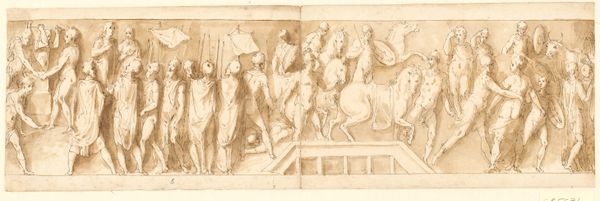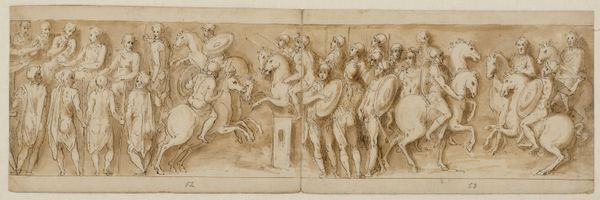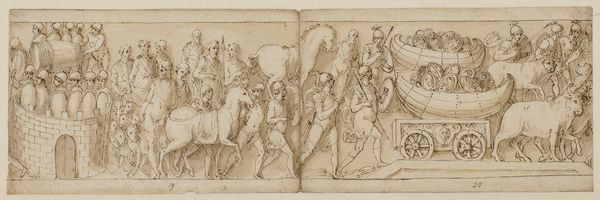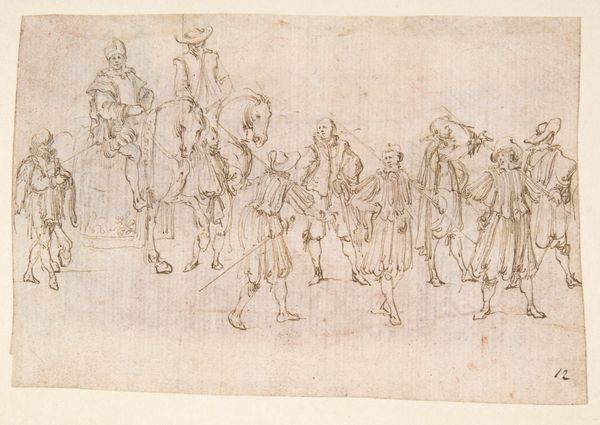
The Sarmatians subject themselves to the emperor (LVI); the Romans attack barbarians (LII) 1544 - 1618
0:00
0:00
drawing, paper, ink, pen
#
drawing
#
narrative-art
#
pen sketch
#
figuration
#
paper
#
ink
#
pen
#
history-painting
Dimensions: 133 mm (height) x 432 mm (width) (bladmaal)
Curator: Look at this detailed drawing, "The Sarmatians subject themselves to the emperor; the Romans attack barbarians" by Giovanni Guerra. It was created sometime between 1544 and 1618 using pen and ink on paper. Editor: Immediately I notice the tension, the drawing captures movement, but it feels somewhat static, like a frieze. There's something unsettling about that controlled energy. Curator: Guerra was fascinated by the artistic and material possibilities of representing power, and this piece is no exception. Think about the production of ink in that period; the materials sourced, ground, mixed – and consider how that material process is linked to the depiction of the Roman empire asserting its dominance. Editor: Absolutely, and this isn't just about material dominance, but cultural subjugation. The composition is incredibly strategic. On one side, we see submission, and on the other, violent attack. It’s a stark visual binary. Curator: Consider the choice of ink; a controlled, deliberate medium that enables precise detail and clean lines. He has elected for paper, perhaps indicating a preparatory drawing. The final project may well have been in a material representing a more established assertion of dominance. Editor: That deliberate technique further underscores the unequal power dynamics at play. There is this sense that the ‘barbarians’ are figures without agency in this story, destined to be victims or submitters in service of the Emperor's project. What does it tell us about the Roman worldview, that it allows only these two limited roles to outsiders? Curator: I think Guerra uses these clean and definitive lines and the clear medium of ink and paper to define the boundary between conqueror and conquered, reflecting the seemingly unambiguous power relations within the empire itself. Editor: It is a perfect, though rather frightening illustration of the ancient dictum: History is written by the victors. This sketch highlights the narratives, but also how imperial violence writes itself, quite literally, onto the world through tools and artistic productions like this. Curator: Considering Guerra’s methods adds another dimension to our understanding of historical narratives, allowing us to analyse art both aesthetically, but more importantly, how he uses materials to shape and disseminate these power narratives. Editor: Yes, by examining this piece and how it actively depicts historical tensions, we can engage in necessary discussions of identity and geopolitical power imbalances – debates that, regrettably, are far from relegated to the history books.
Comments
No comments
Be the first to comment and join the conversation on the ultimate creative platform.




